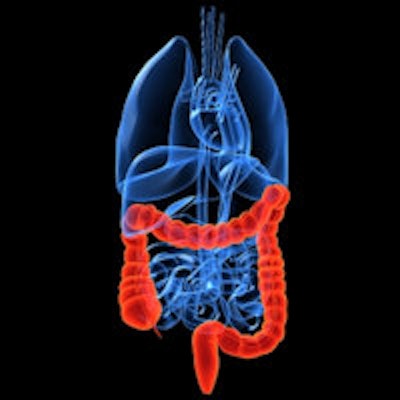
Women can be screened for colorectal cancer five to 10 years later than men, according to an Italian study published on June 11 in Cancer. The different findings for men and women in more than 7,000 patients could eventually translate into different screening recommendations based on gender, the investigators wrote.
Multivariate models of the study data showed that age and male sex were both independent predictors of advanced neoplasia at virtual colonoscopy (also known as CT colonography or CTC). On the other hand, neither a family history of the disease nor body mass index (BMI) predicted the presence of advanced neoplasia in the study population.
The number of screened patients needed to detect one case of advanced neoplasia varied from 51 among women 55 years or younger to 10 for men 65 years and older, the study team wrote. Are age and gender the main cofactors, then, for colorectal cancer risk?
The results suggest "equivalence in the role of age and sex in stratifying average-risk individuals between CTC and colonoscopy," wrote Dr. Cesare Hassan, Dr. Perry Pickhardt, and colleagues from Nuovo Regina Margherita Hospital in Rome, the University of Wisconsin in Madison, and the Humanitas Institute in Milan. "The greater than fourfold variation in [number needed to screen (NNS)] to detect advanced neoplasia according to age and sex may be informative when planning for general population screening" (Cancer, June 11, 2013).
If men are advised to begin colorectal cancer screening at age 50, how much longer can women wait? "Probably [age] 60 may be recommended for an imaging study, while fecal tests may be an option between 50 and 60," lead author Hassan wrote in an email to AuntMinnie.com.
Aiming for less-invasive screening
Concerns about the high cost and invasiveness of conventional screening techniques such as optical colonoscopy have led to increasing interest in CTC for population-based screening for colorectal cancer -- typically individuals age 50 or older, as universally recommended by the American Cancer Society and other organizations. However, previous studies have not looked at the age at which virtual colonoscopy should first be performed.
"The primary objective of this study was to derive and validate a model for the detection of advanced colorectal neoplasia during screening CTC using age, sex, a positive family history of [colorectal cancer (CRC)], and BMI as predictive variables," the authors wrote.
Secondary objectives included determining the NNS to find a single cancer at CTC, and determining the number of conventional colonoscopies after CTC needed to find a case of advanced neoplasia in each of the risk groups.
Patients referred for first-time screening CTC from 2004 to 2011 at a single medical center were enrolled. Any CTC exam finding a polyp 6 mm or larger was defined as positive in accordance with the CT Colonography Reporting and Data System (C-RADS), and colonoscopy findings were categorized based on the most advanced lesion identified.
The researchers referred patients who had a polyp 10 mm or larger or more than two small polyps (6-9 mm) at CTC for conventional colonoscopy. The results of colonoscopy, polypectomy, and any final histologic results were logged for all patients undergoing colonoscopy.
The group used logistic regression to identify significant predictor variables for advanced neoplasia (any adenoma 10 mm or larger with a villous component, high-grade dysplasia, or adenocarcinoma). Associations between study variables -- age, sex, BMI, and a positive family history of colorectal cancer -- and advanced neoplasia were expressed using odds ratios (OR).
Among the 7,620 individuals (mean age, 56.7 ± 7.3 years) undergoing CTC screening, 276 (3.6%; 95% confidence interval [CI]: 3.2%-4.1%) were eventually diagnosed with advanced neoplasia. Mean BMI was 28.1 ± 7.1 kg/m2, and 66% of the cohort presented with a BMI of at least 25 kg/m2, the authors wrote.
Multivariate analysis showed that age at screening (mean OR per 10-year increase, 1.8; 95% CI: 1.6-2.0) and being male (OR, 1.7; 95% CI: 1.3-2.2) were independent predictors of advanced neoplasia. BMI and a positive family history of colorectal cancer were not predictors.
The number needed to screen to detect a single case of advanced neoplasia varied from 51 among women 55 years or younger to 10 among men older than 65 years. The number of post-CTC colonoscopies needed to detect a single case of advanced neoplasia ranged from two to four.
"According to our study, age and sex are associated significantly with the detection of advanced neoplasia in a large cohort of individuals undergoing first-time CTC screening, allowing for clinically relevant risk stratification of the study population," the authors wrote.
| Colonoscopy findings after CTC in men vs. women | |||||
| All patients (n = 7,620) | Women < 55 years | Women ≥ 55 years | Men < 55 years | Men ≥ 55 years | |
| Advanced neoplasia | 3.6% | 2% | 3.4% | 3.1% | 5.8% |
| Any adenoma ≥ 6 mm | 6.3% | 4% | 5.7% | 6.3% | 9.2% |
| Nonneoplasic polyp ≥ 6 mm | 2% | 1.3% | 2% | 2.5% | 2.3% |
The wide interval of the number needed to screen with CTC to detect one advanced neoplasia (ranging from 10 to 51) closely approximates the results of a previous study by Regula et al in a large cohort undergoing screening colonoscopy, the authors noted.
"The greater than fourfold variation in NNS to detect advanced neoplasia according to age and sex may be informative when planning for general population screening," they wrote. "In cases of limited resources, which are likely to occur when CRC screening is recommended for all adults aged > 50 years, it makes sense for health systems to target patients with a greater expected benefit to best use the available economic and medical resources."
The approach has been used before in adopting selective cutoff values for the use of colonoscopy resources after sigmoidoscopy or immunochemical fecal testing, they added, though no guidelines have proposed different age thresholds for the sexes.
"Women appear to reach the same NNS as men with an approximate 10-year delay," they wrote. "Thus, it would seem reasonable to propose different age recommendations for CTC screening according to sex, whereas perhaps a less costly strategy, such as fecal occult blood testing, could be used earlier."
The finding that women younger than 65 and men younger than 55 have a number needed to screen below the study-wide mean NNS of 28 suggests that "screening these patients represents a somewhat less efficient use of CTC," the authors wrote.
Stratifying the study population by age and sex revealed a twofold difference in the efficiency of post-CTC colonoscopy, ranging from two to four procedures to find a single case of advanced neoplasia.
"In instances of limited endoscopic capacity, this information could trigger more conservative nonendoscopic surveillance policies for those CTC-positive individuals who have a lower risk of advanced neoplasia or the adoption of a more selective post-CTC dimensional cutoff for referring patients to polypectomy," Hassan and colleagues wrote.
If less screening is justified in some individuals, how might clinicians approach the question of how to cut back? Would more frequent follow-up be reserved for individuals with more or larger lesions that still fall within the 6- to 9-mm diameter threshold?
"I cannot see different recommendation at this time for post-CTC colonoscopy threshold according to age and sex," Hassan told AuntMinnie.com. "On the other hand, in a screening setting, the adoption of a 10-mm cutoff, irrespective of age and sex, may be a reasonable compromise between efficacy and efficiency."
Finally, the study was somewhat unusual in its conclusion that family history and BMI were not linked with the risk of advanced neoplasia.
"We could not confirm the role of a positive family history of CRC in stratifying for the risk of advanced neoplasia," the authors wrote. "When considering the relatively low prevalence of a positive family history of CRC -- 3% in our cohort compared with 13.3% in a previous endoscopic series -- we cannot exclude the possibility that the lack of an association simply may be attributed to a sample size bias."
As for the lack of an association with BMI, the authors noted that 66% of the study population reported a BMI ≥ 25 kg/m2; therefore, any eventual impact of the variable would have been substantial. The results, in line with a previous study by the authors, suggest that "obesity appears to be involved in tumor initiation (i.e., adenoma formation) rather than tumor progression (i.e., advanced neoplasia)."
Among the study limitations, about one-third of the patients entered surveillance with detected 6- to 9-mm lesions, potentially underestimating the prevalence of advanced neoplasia in the study population.
"Age and sex appear to be useful variables for predicting the risk of advanced neoplasia at screening CTC, whereas BMI and a positive family history of CRC do not appear to have a major impact," Hassan and colleagues concluded.



















